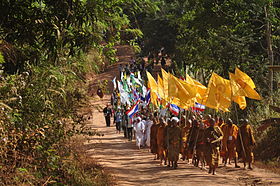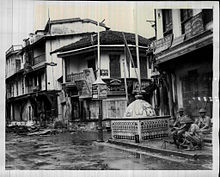Communal violence

Communal violence is a form of violence that is perpetrated across
United Nations Office on Drugs and Crime includes any conflict and form of violence between communities of different religious groups, different sects or tribes of same religious group, clans, ethnic origins or national origin as communal violence.[3] However, this excludes conflict between two individuals or two families.
Communal violence is found in Africa,[4][5] the Americas,[6][7] Asia,[8][9] Europe[10] and Oceania.[11]
The term "communal violence" was coined by European colonial authorities as they wrestled to manage outbreaks of violence between religious, ethnic and disparate groups in their colonies, particularly Africa and South Asia, in early 20th century.[12][13][14]
Communal violence, in different parts of the world, is alternatively referred to as ethnic violence, non-State conflict, violent civil disorder, minorities unrest, mass racial violence, inter-communal violence and ethno-religious violence.[15]
History
Europe
Human history has experienced numerous episodes of communal violence.
Africa
The
Asia

Communalism is a term historically used to denote attempts to construct religious or ethnic identity, incite strife between people identified as different communities, and to stimulate communal violence between those groups, particularly in Asia.
The term communalism was coined by the British colonial government as it wrestled to manage
The
East, South and Southeast Asia have recorded numerous instances of communal violence. For example, Singapore suffered a wave of communal violence in 20th century between Malays and Chinese.[41] In Indian subcontinent, numerous 18th through 20th century records of the British colonial administration mention communal violence between Hindus and Muslims, as well as Sunni and Shia sects of Islam, particularly during processions related to respective religious celebrations.[42][43]
The frequency of communal violence in South Asia increased after
It has recently been argued that in the post-colonial era, communal riots between the Hindus and the Muslims contributed to the making of Muslim ghettos in those cities that had witnessed sustained communal mobilizations. It has furthermore been shown that the communalized real estate market, urban planning, and communal mobilizations often come to constitute each other in developing spatial majoritarianism.[49]
The 20th century witnessed inter-religious, intra-religious and ethnic communal violence in the Middle East, South Russia, Eastern Europe, Central Asia, South Asia and Southeast Asia.[12][50]
National laws
India
The Indian law defines communal violence as, "any act or series of acts, whether spontaneous or planned, resulting in injury or harm to the person and or property, knowingly directed against any person by virtue of his or her membership of any religious or linguistic minority, in any State in the Union of India, or Scheduled Castes and Scheduled Tribes within the meaning of clauses (24) and (25) of Article 366 of the Constitution of India" [51]
Indonesia
In Indonesia, communal violence is defined as that is driven by a sense of religious, ethnic or tribal solidarity. The equivalence of tribalism to ethnicity was referred locally as kesukuan.[12] Communal violence in Indonesia includes numerous localized conflicts between various social groups found on its islands.[52]
Kenya
In Kenya, communal violence is defined as that violence that occurs between different community who identify themselves based on religion, tribes, language, sect, race and others. Typically this sense of community identity comes from birth and is inherited.[53] Similar definition has been applied for 47 African countries, where during 1990–2010, about 7,200 instances of communal violence and inter-ethnic conflicts has been seen.[54]
Causes

Colm Campbell has proposed, after studying the empirical data and sequence of events during communal violence in South Africa, Palestinian Territories and Northern Ireland, that communal violence typically follows when there is degradation of rule of law, the state fails to or is widely seen as unable to provide order, security and equal justice, which then leads to mass mobilization, followed by radicalization of anger among one or more communities, and ultimately violent mobilization. Targeted mass violence by a few from one community against innocent members of other community, suppression of complaints, refusal to prosecute, killing peaceful demonstrators, imprisonment of people of a single community while refusal to arrest members of other community in conflict, perceived or actual prisoner abuse by the state are often the greatest mobilizers of communal violence.[55][56]
Research suggests that ethnic segregation may also cause communal violence. Empirically estimating the effect of segregation on the incidence of violence across 700 localities in Rift Valley Province of Kenya after the contested 2007–2008 general election, Kimuli Kahara finds that local ethnic segregation increases communal violence by decreasing interethnic trust rather than by making it easier to organize violence.[57] Even if a small minority of individuals prefer to live in ethnically homogenous settings due to fear of other ethnic groups or otherwise, it can result in high degrees of ethnic segregation.[58] Kahara argues that such ethnic segregation decreases the possibility of positive contact across ethnic lines.[59] Integration and the resultant positive interethnic contact reduces prejudice by allowing individuals to correct false beliefs about members of other ethnic groups, improving intergroup relations consequently.[60] Thus, segregation is correlated with low levels of interethnic trust. This widespread mistrust along ethnic lines explains the severity of communal violence by implying that when underlying mistrust is high, it is easier for extremists and elites to mobilize support for violence, and that where violence against members of other ethnic groups is supported by the public, perpetrators of such violence are less likely to face social sanctions.[61]
Alternate names
In China, the communal violence in Xinjiang province is called ethnic violence.[62] Communal violence and riots have also been called non-State conflict,[63] violent civil or minorities unrest,[64] mass racial violence,[65] social or inter-communal violence[66] and ethno-religious violence.[67]
See also
- Anti-Hindu sentiment
- Ayodhya dispute (India)
- Citizenship (Amendment) Act, 2019 (India)
- Communal conflicts in Nigeria
- Ethnic cleansing in Bhutan
- Ethnic conflict
- Ethnic relations in India
- Hate group
- Sectarian violence between Tibetans and Hui Muslims
- July 2009 Ürümqi riots – Described as Communal riots
- Language conflicts in India
- List of ethnic riots
- NCERT textbook controversies (India)
- Pogrom
- Religion in India
- Religious harmony in India
- Religious violence in India
- Rohingya conflict (Myanmar)
- Saffronisation
- Saffron Terror
- Sectarian violence
- Sectarianism
- Secularism in India
- Structural abuse
- Structural violence
- Tarakan riot
- Terrorism in India
- The Last King of Scotland
References
- ^ Horowitz, D.L. (2000) The Deadly Ethnic Riot. University of California Press, Berkeley and Los Angeles, CA
- ^ Communal[dead link] Oxford Dictionaries
- ^ Homicide, Violence and Conflict UNODC, United Nations
- ^ Kynoch, G. (2013). Reassessing transition violence: Voices from South Africa's township wars, 1990–4. African Affairs, 112(447), 283–303
- ^ John F. McCauley, Economic Development Strategies and Communal Violence in Africa, Comparative Political Studies February 2013 vol. 46 no. 2 182–211
- ^ Willis, G. D. (2014), Antagonistic authorities and the civil police in Sao Paulo Brazil, Latin American Research Review, 49(1), 3–22
- ^ Resource guide for municipalities UNODC
- ^ Mancini, L. (2005) Horizontal Inequality and Communal Violence: Evidence from Indonesian Districts (CRISE Working Paper No. 22, Oxford, Queen Elizabeth House, University of Oxford)
- ISBN 978-1412934114, Chapter 12
- ^ Todorova, T. (2013), ‘Giving Memory a Future’: Confronting the Legacy of Mass Rape in Post-conflict Bosnia-Herzegovina, Journal of International Women's Studies, 12(2), 3–15
- ^ Bell, P., & Congram, M. (2013), Communication Interception Technology (CIT) and Its Use in the Fight against Transnational Organised Crime (TOC) in Australia: A Review of the Literature, International Journal of Social Science Research, 2(1), 46–66
- ^ ISBN 978-0-415-41713-6.
- ISBN 978-0230112575, Palgrave Macmillan, pp 29–32
- ISBN 978-9004088344, Brill Academic
- ISBN 978-0520053854
- ^ a b Parker, G. (ed.) (1994), Atlas of World History, Fourth Edition, BCA (HarperCollins), London;
- "This Day in History 1572: Saint Bartholomew's Day Massacre". History.com. Archived from the original on 12 February 2010. Retrieved 2 August 2010.
- ISBN 0-19-860223-5hardback, pp.585;
- ISBN 0-333-44157-5hardback, pp. 113;
- ISBN 0-7126-0720-Xpaperback, pp.456;
- ^ ISBN 0-233-99666-4;
- Upshall, M. (ed.) (1990), The Hutchinson Paperback Encyclopedia, Arrow Books, London, ISBN 0-09-978200-6
- Upshall, M. (ed.) (1990), The Hutchinson Paperback Encyclopedia, Arrow Books, London,
- ^ David Nirenberg, Communities of Violence: Persecution of Minorities in the Middle Ages, Princeton University Press, 1998
- ^ Pierre-Jean Souriac, "Du corps à corps au combat fictif. Quand les catholiques toulousains affrontaient leurs homologues protestants," in Les affrontements: Usages, discours et rituels, Editor: Frédérique Pitou and Jacqueline Sainclivier, Presses Universitaires de Rennes (2008)
- ^ Julius Ruff, Violence in Early Modern Europe 1500–1800, Cambridge University Press, 2001
- ISBN 978-0719051180, pp. 90–99
- ^ Samuel P. Huntington, The Clash of Civilizations?, Foreign Affairs, Vol. 72, No. 3 (Summer, 1993), pp. 22–49
- ISBN 978-1137325297
- ^ Conley, Robert (14 January 1964), "Regime Banishes Sultan", New York Times, p. 4, retrieved 16 November 2008.
- ISBN 978-0-325-07068-1
- ^ Conley, Robert (19 January 1964), "Nationalism Is Viewed as Camouflage for Reds", New York Times, p. 1, retrieved 16 November 2008
- ^ Los Angeles Times (20 January 1964), "Slaughter in Zanzibar of Asians, Arabs Told", Los Angeles Times, p. 4, archived from the original on 17 October 2012, retrieved 16 April 2009
- ISBN 0-7735-1218-7
- ISBN 1-85065-066-7
- ISBN 978-0813122335, pp 182–187
- ^ Heba Saleh, Christians targeted in communal violence in Egypt The Financial Times (August 16, 2013)
- ISBN 978-0415811248, Routledge, pp 272–279
- ISBN 978-0520053854.
- ^ a b Pandey, Gyanendra (2006). The Construction of Communalism in Colonial North India. Oxford India.
- ISSN 0362-4331. Retrieved 2020-06-07.
- ISBN 978-0230112575.
- ISBN 978-9004088344.
- ISBN 978-93-5260-363-3.
- ISBN 9780140100839.
- ^ "BBC - History - British History in depth: The Hidden Story of Partition and its Legacies". BBC. Retrieved 2020-06-07.
- ^ Leifer, Michael (1964), Communal violence in Singapore, Asian Survey, Vol. 4, No. 10 (Oct., 1964), 1115–1121
- ^ Bayly, C. A. (1985), The Pre-history of Communalism? Religious Conflict in India 1700–1860, Modern Asian Studies, 19 (02), pp. 177–203
- ^ Baber, Z. (2004), Race, Religion and Riots: The ‘Racialization’ of Communal Identity and Conflict in India, Sociology, 38(4), pp. 701–718
- ISBN 978-0836400007
- ISBN 978-0304304813
- ISBN 978-0195633658
- ISBN 978-0853071327
- ISBN 978-0198077305
- ^ Bandyopadhyay, Ritajyoti, Streets in Motion: The Making of Infrastructure, Property, and Political Culture in Twentieth-century Calcutta, Cambridge: Cambridge University Press, 2022:https://doi.org/10.1017/9781009109208
- ^ Tambiah, S. J. (1990), Presidential address: reflections on communal violence in South Asia, The Journal of Asian Studies, 49(04), pp 741–760;
- Vaughn, B. (2005, February), Islam in South and Southeast Asia. LIBRARY OF CONGRESS, WASHINGTON DC, CONGRESSIONAL RESEARCH SERVICE (2005);
- Baker & Hamilton (2006), The Iraq study group report, Random House, ISBN 978-0307386564;
- Azra A. (2006), Indonesia, Islam, and democracy: Dynamics in a global context, Equinox Publishing, ISBN 978-9799988812, pp. 72–85
- ^ PREVENTION OF COMMUNAL AND TARGETED VIOLENCE (ACCESS TO JUSTICE AND REPARATIONS) BILL, 2011 Archived 2014-08-14 at the Wayback Machine Government of India
- ^ Social violence in Indonesia is localized Archived 2016-03-04 at the Wayback Machine Jakarta Post
- ^ COUNTRY REPORT: KENYA – 2013 ACLED, Africa (2014)
- ^ Idean Salehyan et al, Social Conflict in Africa: A New Database, International Interactions: Empirical and Theoretical Research in International Relations, Volume 38, Issue 4, 2012
- ^ Colm Campbell (2011), 'Beyond Radicalization: Towards an Integrated Anti-Violence Rule of Law Strategy', Transitional Justice Institute Research Paper No. 11-05, in Salinas de Friás, KLH Samuel and ND White (eds), Counter-Terrorism: International Law and Practice (Oxford University Press, Oxford 2011)
- ISBN 978-0230245501, Palgrave Macmillan
- ^ Kasara, Kimuli (June 2016). "Does Local Ethnic Segregation Lead to Violence?: Evidence from Kenya". Working Paper.
- .
- ^ Kasara, Kimuli (2016). "Does Local Ethnic Segregation Lead to Violence? Evidence from Kenya". Working Paper.
- S2CID 10722841.
- ^ Kasara, Kimuli (June 2016). "Does Local Ethnic Segregation Lead to Violence?: Evidence from Kenya". Working Paper.
- ^ A. R. M. Imtiyaz, Uyghurs: Chinesization, Violence and the Future, Temple University, IUP Journal of International Relations, Vol. 6, No. 1, pp. 18–38, Winter 2012
- ^ UCDP Non-State Conflict Dataset Archived 2015-01-22 at the Wayback Machine Sweden (May 2014)
- ^ French Civil Unrest Subsides The New York Times (2005)
- ISBN 978-0-202-362632
- ^ THE INTER-COMMUNAL TRUST BUILDING PROJECT Harvard University
- ISBN 978-0-415-453806
Bibliography
- Bayly, C. A. (1985). "The Pre-history of 'Communalism'? Religious Conflict in India, 1700-1860". Modern Asian Studies. 19 (2): 177–203. S2CID 106402178.
- Gould, William (2011). Religion and Conflict in Modern South Asia. ISBN 978-1-139-49869-2.
- Heath, Deana; Mathur, Chandana, eds. (2010), Communalism and Globalization in South Asia and Its Diaspora Intersections: Colonial and Postcolonial Histories, ISBN 9781136867873 – via Google Books
- ISBN 0195630106 – via Google Books.
- Talbot, Ian (2007). "Religion and violence: The historical context for conflict in Pakistan". In Hinnells, John; King, Richard (eds.). Religion and Violence in South Asia: Theory and Practice. ISBN 978-1-134-19218-2 – via Google Books.
- van der Veer, Peter (1994). Religious Nationalism: Hindus and Muslims in India. ISBN 978-0-520-08256-4 – via Google Books.
Further reading
- ISBN 0706926552.
- ISBN 8173041326.
- Jhingran, Saral. "Religion and communalism"
- ISBN 81-7370-040-0.
- Ludden, David, editor. Contesting the Nation: Religion, Community, and the Politics of Democracy in India, Philadelphia: University of Pennsylvania, 1996.
- Manuel, Peter. "Music, the Media, and Communal Relations in North India, Past and Present," pp. 119–39.
- ISBN 978-0-226-50878-8
- Mumtaz Ahmad, an 'Islamic Fundamentalism in South Asia: The Jamaat-i-Islami and the Tablighi Jamaat', pp. 457–530.
- Gold, Daniel, 'Organized Hinduisms: From Vedic Truths to Hindu Nation', pp. 531–593.
- T. N. Madan, 'The Double-Edged Sword: Fundamentalism and the Sikh Religious Tradition', pp. 594–627.
- A History of the Hindu-Muslim Problem in India from the Earliest Contacts Up to its Present Phase With Suggestions for Its Solution. Allahabad, 1933. Congress report on the 1931 Cawnpur Riots.
- Nandini Gooptu, The Urban Poor and Militant Hinduism in Early Twentieth-Century Uttar Pradesh, Modern Asian Studies, Cambridge University Press (1997).
External links
- The Oxford Handbook of Religion and Violence, Michael Jerryson, Mark Juergensmeyer, and Margo Kitts, ISBN 9780199759996
- Encyclopedia of Violence, Peace, and Conflict, 2nd Edition, Lester Kurtz, ISBN 978-0123695031
- Communal violence in South Asia
- 2009 Ürümqi riots at Yahoo! News
- B. R. Ambedkar. "The riot-torn history of Hindu-Muslim relations, 1920–1940". Pakistan or Partition of India.
- Tony Cross. Gujarat after the riots + Mumbai, during 2004 general election
